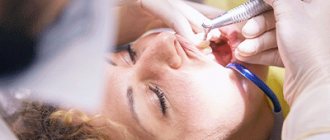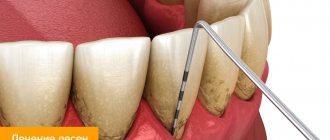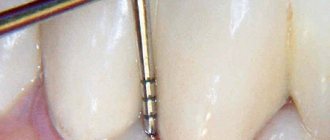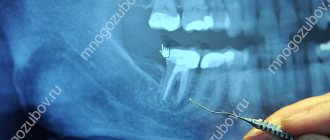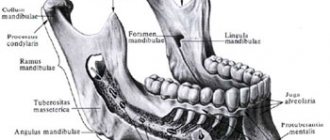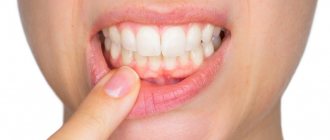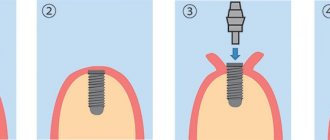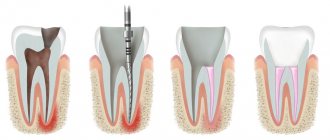Why is the tooth root exposed?
The reasons for the development of gum recession can be different, and in some cases there is a combination of several factors at the same time.
- aggressive brushing with a toothbrush - there is such a thing as brush gum recession. They occur when there is excessive pressure on the toothbrush when brushing, or when using a brush of unsuitable stiffness (hard). If you have increased tooth sensitivity when brushing, if your toothbrush becomes deformed over time (the villi move in different directions), you should consult a dentist about proper self-hygiene.
An example of brush gum recession on the upper jaw.
- incorrect position of the tooth in the dentition. Sometimes even a small bite problem can lead to gum pathology. This occurs because the tooth bears excess load when chewing or when teeth are closed, which over time leads to atrophy of the tissues of the supporting apparatus of the tooth, including the gums. In addition, excessive protrusion of the tooth root from the dentition also leads to gum atrophy.
Multiple gum recessions caused by malocclusion.
- caries - in cases of gingival caries, gum loss often occurs due to the presence of an infectious focus in the immediate vicinity of the gingival margin.
Gum recession caused by tooth decay in the immediate vicinity of the gum margin.
- Tartar can also cause root exposure.
- anatomical features - for example, a thin biotype of gingival tissue in combination with other factors can lead to recession. Shallow vestibule of the oral cavity (in which the muscles of the lips attach very close to the gingival margin and gradually “pull back” it, exposing the roots of the teeth). In addition, improper attachment of the lip and tongue frenulum can contribute to gum recession.
The frenulum of the lower lip, a thin tissue biotype, caused the exposure of the lower incisor root
- bad or professional habits - for example, chewing a pen/pencil, biting threads (for a seamstress), pinching metal objects with teeth, etc.
- lip or tongue piercing - constantly touching the gums and regularly injuring it, metal jewelry can lead to exposure of the roots of the teeth.
- periodontitis - with inflammatory diseases of the gums, the roots are often exposed due to the resorption of the tissues surrounding the tooth, including gum tissue. Unlike “normal” gum recession, periodontitis is treated differently and the prognosis for such recessions is somewhat worse (as a rule, it is impossible to restore the volume of lost gum by completely covering the exposed root).
Reasons for changing the size of the flushing hole
The gap may increase for the following reasons:
- tissue inflammation, accompanied by periodontal destruction (can occur when the immune system is weakened, as well as along with allergic manifestations and oral infections);
- violation of the sealing of the fixing elements of the orthopedic structure;
- damage to the integrity of the bridge at the junction with the crown (even minor damage to the prosthesis leads to its displacement and subsequent impact on the tissue around the tooth);
- poor oral hygiene and inflammation of the gums leads to their enlargement, due to which the rinsing hole is reduced;
- improper preparation of the oral cavity (poor sanitation, etc.) leads to damage to the enamel, due to which the gums rise above the coronal part;
- periodontal diseases, which entails a change in the original position of individual elements of the dentition.
Errors by the dentist or non-compliance with the technological process when installing a prosthesis can result in either an increase in the rinsing space or its complete absence.
Reference! Fixing the bridge too tightly increases the risk of injury to the gums in all parts of the oral cavity. Insufficient fit of the prosthesis, in turn, can lead to impaired speech functions, cause difficulties while eating and even difficulty breathing.
Deviation of the planting density from the norm is fraught with rapid damage to the structure beyond the possibility of repair.
How to treat gum recession?
To cover the exposed root, a small operation is performed in the gum area.
There are many methods of gum plastic surgery, but they are fundamentally divided into 2 types:
- gum plastic surgery with local tissues (when the existing gum is “stretched” or moved to the root in a certain way so that the exposed area is closed, and fixed with small sutures, which are removed after healing).
- gum plastic surgery using a “patch” (the patch can be a special collagen-based material or the patient’s own tissue from the hard palate or the area of the far upper tooth - gum transplantation).
The choice of method is at the discretion of the doctor, according to each specific situation.
Is gum grafting painful?
No . Operations to eliminate gum recession are performed under local anesthesia; the surgical intervention is 100% painless. In the postoperative period, especially with gum plastic surgery using local tissues, patients often do not experience pain at all. If pain occurs, it is usually only on the day of surgery, a couple of hours after the intervention, when the effect of the local anesthetic wears off. During this period, the pain is perfectly eliminated with painkillers prescribed by the doctor. During the entire rehabilitation period, on average, 1-2 painkiller tablets are required.
In cases of gum plastic surgery using a “patch,” unpleasant sensations may be added due to the presence of a donor zone, which, according to patients, resembles the feeling “as if you grabbed hot tea,” but this does not always occur. The presence/absence of pain is determined by the area from which the “patch” is taken. If anatomical conditions allow, doctors can remove the graft from the donor area absolutely painlessly.
How is gingivoplasty performed?
The operation does not require hospitalization or general anesthesia. The procedure can be performed as an outpatient visit to a doctor and under local anesthesia. With the help of effective modern anesthetics, gum grafting is performed completely painlessly.
If it is difficult for the patient to attend his own operation, then various options for premedication and sedation are provided for this.
In most cases, if it is necessary to fill the gum volume, the use of a donor flap is required. Often this is a fragment of the patient’s own mucosa from the tubercle of the upper jaw, palate or the area behind the lower teeth (retromolar). The area from which donor material is collected is dictated by the type of manipulation and the volume of tissue required.
In case of insufficient number of donor tissues, artificial materials are used. Plastic surgery of the lower gum is considered easier, but in reality, healing of the mucous membrane after surgery in any case occurs rapidly - in the oral cavity, tissue regeneration occurs very quickly.
Types of gingivoplasty
Depending on the diagnosis and health status of the patient, the surgical tactics may vary.
- When it is necessary to increase the gum or fill its defect - gingivoplasty
First, the site where the donor site will be placed is prepared, and then a free connective tissue graft is collected. After suturing the donor flap with the recipient area, the intervention is considered complete.
Sometimes the graft is placed in the implant area into a pocket or tunnel formed in the recipient area. To do this, the donor fragment is first de-epithelialized.
There are other methods, their choice is dictated by indications and capabilities.
- In case of incomplete tooth eruption - gingivotomy
An incision is made in the gum in the area of the tooth crown. The size of the excised area depends on the position and size of the tooth.
- If there is excess mucosal tissue – gingivectomy
If there is a periodontal pocket or various types of hypertrophy, the surgeon excises excess mucosa and tightly suturing the edges of the wound so that the mucosa is at the desired height and tightly covers the necks of the teeth.
Operation duration
The intervention can last 1-3 hours, depending on the volume and degree of complexity. The most complex situations are treated in several stages. For example, in order for the patient to undergo gum surgery more comfortably, it is recommended to operate on each side (left, right) in turn - then he will be able to chew food and sleep on at least one side.
Rehabilitation after gum surgery
Due to the high speed of regenerative processes in the oral cavity, gum healing after plastic surgery occurs in just 1-2 days. It is during this period that it is important to follow the rules of rehabilitation and the doctor’s recommendations to accelerate the epithelization of the wound, so that pain after gum surgery does not bother you too much:
- Avoid solid and irritating foods - sour, salty, spicy, cold;
- Stop smoking, alcohol, active sports, and shaking in transport;
- Carry out hygienic care very carefully (don’t even rinse too vigorously);
- Do not make suction movements, do not touch the wound with your tongue or any objects;
- Try to eat alkaline foods, as acidification of the pH of saliva promotes inflammatory processes.
How long it takes for the gums to heal completely after plastic surgery, that is, with complete restoration of blood supply, innervation and molecular connections, depends on the individual characteristics of the patient’s body. Sometimes final rehabilitation can take up to 3 months.
Swelling after gum surgery goes away within a few days (up to a week). At this time, slight tooth mobility and hypersensitivity are allowed. Some clinics provide the patient with a special mouthguard with a disinfecting effect, which accelerates wound healing.
What effect can be expected after gingivoplasty?
In addition to correcting aesthetics, the goal of surgical intervention is to prevent the development of many complications - tooth loss, deepening of periodontal pockets, the formation of wedge-shaped defects, hypersensitivity of the necks and roots of teeth.
Thanks to gingivoplasty, hygiene is facilitated, bleeding gums, bad breath, inflammation are eliminated, and tartar forms more slowly. Also, after plastic surgery, the possibilities for prosthetics and implantation expand - the patient has fewer contraindications for any dental procedures and manipulations.
Perioplasty - plastic surgery of the gums around implants - improves blood circulation in the implantation area, hygiene, and extends the life of artificial roots.
Complications after gum surgery
The operation can have complications during the rehabilitation period only if:
- Incorrect history taking - the doctor did not find out (or the patient was able to hide) the patient’s health problems, the presence of factors that complicate wound healing (for example, with immune problems);
- Non-compliance with the doctor’s recommendation - if the patient has neglected the rules of gentle care, does not follow the instructions for anti-inflammatory therapy, disinfection, lifestyle and others;
- Medical error - in case of infection in the wound, leaving a foreign body (bandage thread, bone fragment).
On the last point, gum plastic surgery is the least likely to have complications, because modern operating algorithms and antiseptics, sterile packaged instruments and suture material, disposable consumables - all this leaves practically no chance for infection.
It is much more important to take seriously the rules of the postoperative period, not to smoke, to make a proper menu and to care for the wound surface as necessary.
What are the features and complications after gum recession surgery?
With a mild course of the rehabilitation period, patients do not note any peculiarities . But sometimes it is possible:
- the appearance of white plaque on the gums (this is normal, one of the healing options after gum surgery).
- swelling of the soft tissues of the face (from minor swelling to significant) depending on the extent of the surgical intervention (number of teeth involved), the size of the recession, the method of its closure, anatomical features and the patient’s body.
- hematomas on the facial skin (rarely encountered with gum surgery).
- increase in body temperature.
- pain (relieved by painkillers).
Diagnosis of the disease
An effective treatment method for gum recession is selected depending on the causes and forms of the disease. For this purpose, a thorough diagnosis is carried out, which includes:
- Visual and instrumental examination of the oral cavity
- Drawing up a periodontogram - assessing the condition of periodontal tissues, the volume of dental plaque and the depth of periodontal pockets
- Computed tomography is the most reliable way to assess the quality of the surrounding bone, the stage of the pathological process, the sunken bone tissue
Computed tomography gives a complete picture of the condition of the bone tissue, on the basis of which the severity of the pathology is determined and the optimal treatment regimen is selected
What are the recommendations and restrictions after gum recession surgery?
- Do not disturb the wound surface (with tongue, food, foreign objects, etc.) this is the main condition for good healing.
- Do not bite (food eaten should be soft or finely chopped).
- Do not brush your teeth in the surgical area with a toothbrush (hygiene in this area should be maintained only as permitted by the attending physician).
- Do not eat or drink hot foods.
- Avoid physical activity.
- Follow the recommendations of your doctor and take prescribed medications.
What happens if gum recession is not treated?
- root caries (the root, unlike the crown of the tooth, is not covered with enamel - a dense “pearl” shell, and therefore is more vulnerable). Normally, the root is covered by the gum and is not exposed to the aggressive environment of the oral cavity (acids, humidity, microorganisms, enzymes). With gum recession, the exposed root is susceptible to destruction.
- abrasion of root tissues (again, due to the lack of enamel, tooth root tissues are not resistant to abrasion).
- increased sensitivity of teeth.
- the transition of a recession to a class that is not subject to complete closure.
- more plaque (the surface of the root is rougher than the surface of the tooth crown, which means that plaque is retained more when the roots are exposed).
Large gum recession, caries of the exposed tooth root, an abundance of soft plaque on the root surface.
Signs of the disease
Gum recession is not an independent disease, but only a manifestation of some other pathology
At the initial stage it is asymptomatic. Usually the problem is detected when the level of mucous membrane has already significantly decreased and tooth roots are exposed. Outwardly it looks like a cosmetic defect in the dentition. In the affected area, the teeth visually appear longer due to a decrease in the height of the gingival margin, and a stepped defect is visible at their base.
Associated symptoms:
- Bleeding gums
- Swelling and redness
- Increased tooth sensitivity
- Painful sensations upon contact with the brush, while eating
- Formation of periodontal pockets
- Tooth mobility
